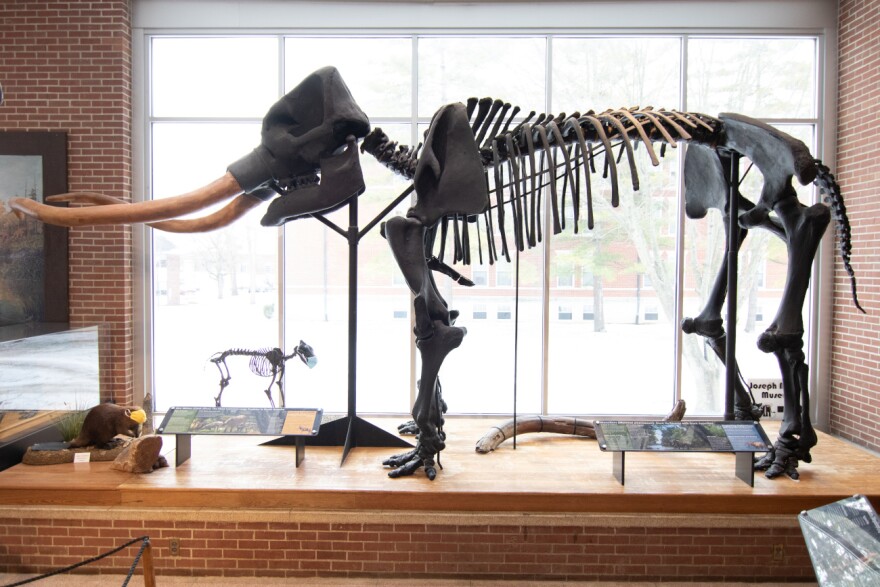The trilobite is the state fossil of Ohio. In Kentucky, it's the brachiopod. In Indiana, it's the, well, it's nothing, but that has now changed.
Indiana has a state bird — the cardinal — a state river — the Wabash — and a state nickname no one can seem to agree on the origins of (the Hoosier)... but a local congressman hoped people would agree on a state fossil. State Rep. Randy Frye of Greensburg backed House Bill 1013 to make the mastodon the official state fossil of Indiana.
"The benefit of having a state fossil would be for education purposes, that young people as young as kindergarten can understand that something as big as an elephant that walked on the very ground that they might be on on the playground and how enormous they were and yet right where we are," Frye told WVXU in February. "As an education tool I think it's fantastic."
Mastodons roamed the earth during the Ice Age. They went extinct around the end of the Pleistocene some 10,000 years ago.
Heather Lerner is the director of the Joseph Moore Museum at Earlham College in Richmond. She also uses the elephant as a modern day reference.
"It's sort of like, in the elephant family ... their family reunions and like the cousins come, and those are the mammoths. And then there's that group that sometimes shows up and no one's really sure how they're related. Those are the mastodons," she explains with a laugh. "They kind of look like your family and you're like, yeah, we can see how you'd be related, but you're kind of different."
Lerner describes mastodons as shorter than mammoths but stockier. An adult male averaged around 9.5 feet tall at the shoulder.
Now, way back thousands of years ago, mastodons were wandering around North America doing mastodon things in the spruce forest.
"We know from chemical analysis of their teeth and their poop what they were actually eating, and that confirms that it's these habitats that would have been closer to the ice," Lerner says.
She explains the mastodons were chilling along the edge of the glaciers as they were sliding north and south.
"One of the places where you could almost guarantee you were going to find a mastodon, if you were alive in the Ice Age, would have been in Indiana, whereas Michigan or Wisconsin, they would have been there sometimes, but not always because the ice would have been covering it sometimes and so they couldn't have lived there."
Then boom — they all die off, leaving their fossilized remains to show up in farmers fields, stream beds and what not.
"You can kind of think of Indiana as the forever home of mastodons," Learner says.
The Joseph Moore Museum alone has more than 170 mastodon remains. That includes whole skeletons, bone fragments, teeth, toes... They had so many, in fact, they've been able to trade with other museums.
"We're just rolling in mastodons, so you know, we gave one to Cincinnati. We gave one out west to Nebraska so we could get a dinosaur," she says with a laugh.
That's right, if you tour the new Ice Age Gallery at the Cincinnati Museum Center, you'll find the Overmyer Mastodon. It was discovered in a ditch in North Central Indiana in 1976, excavated and preserved by a team from Earlham in '78, and permanently deposited at the Natural History Museum where it went on display for the first time last July.

Rep. Frye — whose district includes Ohio and Switzerland counties along with parts of Dearborn, Ripley and some others — says the remains of approximately 300 mammoths and mastodons have been found in nearly all of the Indiana's 92 counties.
Lerner has a tip if you need help telling mammoths and mastodons apart.
"If you put your arms straight out and curve your little fingers up a little bit — that's what a mastodon tusk is like. But if you're a mammoth, you've got to bend your arms at the elbow and turn your hands inward. And those curved tusks, those are the mammoth tasks. So you can always tell just by those little movements if you're looking at a mammoth or mastodon."
The Indiana House unanimously approved House Bill 1013 in February. It then moved on to consideration in the Senate. Lawmakers on Feb. 14 approved the bill. The change goes into effect July 1.



